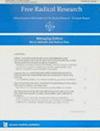In memoriam: Emeritus Professor Robin L. Willson.
IF 3.6
3区 生物学
Q2 BIOCHEMISTRY & MOLECULAR BIOLOGY
引用次数: 1
Abstract
It is with great sadness that we announce the passing of one of the ‘founding fathers’ of the free radical and redox fields, Professor Robin Linhope Willson. He died peacefully at his home in Puerto Madryn, Patagonia, Argentina, where he had lived since retiring from Brunel University. He was 81 and leaves behind a wife Vicky, and two children, Emma and Suzy, from his first marriage to Hester Bowen who died in 1996. In thinking about what highlights to include of the many discoveries associated with Robin Willson, and particularly those of the widest and most-enduring interest to the field of free radical chemistry and biology, the direct observation of the ‘repair’ of radicals formed from the antioxidants, vitamin E and thiols, by ascorbate (vitamin C) immediately springs to mind [1,2]. These observations were reported in a paper with John Packer and Trevor Slater in Nature in 1979 [3] and is Robin’s most cited work ( 2000 citations). However, glancing through the list of Robin’s publications presents a great problem: where to start? This is because Robin led the way in so many different areas, and not just as a scientist, but also as a communicator, educator and inspiration behind the ‘Magic Pennies’ project, which opened the eyes of many children and young adults to the field of magnetism. Robin was born in 1941 in Lytham St Annes, Lancashire, and his scientific career began as a radiation chemist in the mid-1960s in the laboratory of ‘Joe’ Weiss (of Haber-Weiss fame) at the University of Newcastle, UK, after having completed his undergraduate training at King’s College, Durham University. Joe Weiss had, more or less, invented the field of radiation chemistry of biomolecules with his paper in Nature in 1944. With George Scholes, Elie Hayon, Gabriel Stein and Alastair Johnson, the Newcastle group ‘spawned’ a large number of the radiation chemists who went on to have a major international impact in free-radical and radiation biology, including John Ward, Les Redpath and, of course, Robin. The Newcastle group focused on reactions of radicals produced on radiolysis of aqueous solutions of nucleic acids, and Robin’s first papers were in this area; he was awarded his PhD in 1966. After the Cortina International Congress of Radiation Research in 1966, Robin took up a postdoc with Larry Myers at the Laboratory of Nuclear Medicine and Radiation Biology, University of California Los Angeles. While there, he played a major role in developing a nanosecond pulse radiolysis facility at General Atomics, San Diego [4]. He also initiated the use of an early programmable Olivetti calculator for handling the data. After his post-doctoral position in California, Robin was recruited by Ged Adams to strengthen the radiation chemistry group in the Gray Laboratory at Mount Vernon Hospital, Northwood, near London. In 1960, radiation chemistry was revolutionized by the development of kinetic spectrophotometry methods that allowed direct observation and monitoring of radiation-chemical intermediates following short (microsecond) pulses of radiation; the laboratory founded by L.H. Gray was a pioneer in this technique, and in his early years there Robin characterized key reactions relevant to radiation biology. The hydrated electron had been observed directly at Mount Vernon by Ed Hart and Jack Boag in 1962, and Robin’s observations of single electron transfer reactions between molecules of differing electron affinity led the way to a detailed and quantitative understanding of redox reactions involving free radicals [5–9]. Not least of these was the realization that superoxide radicals (O2 ) could be formed as a consequence of radical ‘repair’ by thiols (RSH) [10], the thiyl radicals (RS ) forming disulfide radical-anions, that in turn reduced molecular oxygen to O2 : free radicalþ RSH ! ‘repaired’ speciesþ RS RS þ RS ðRSSRÞ – ðRSSRÞ – þ O2 ! RSSRþ O – 2 :纪念:名誉教授罗宾·威尔逊。
本文章由计算机程序翻译,如有差异,请以英文原文为准。
求助全文
约1分钟内获得全文
求助全文
来源期刊

Free Radical Research
生物-生化与分子生物学
CiteScore
6.70
自引率
0.00%
发文量
47
审稿时长
3 months
期刊介绍:
Free Radical Research publishes high-quality research papers, hypotheses and reviews in free radicals and other reactive species in biological, clinical, environmental and other systems; redox signalling; antioxidants, including diet-derived antioxidants and other relevant aspects of human nutrition; and oxidative damage, mechanisms and measurement.
 求助内容:
求助内容: 应助结果提醒方式:
应助结果提醒方式:


